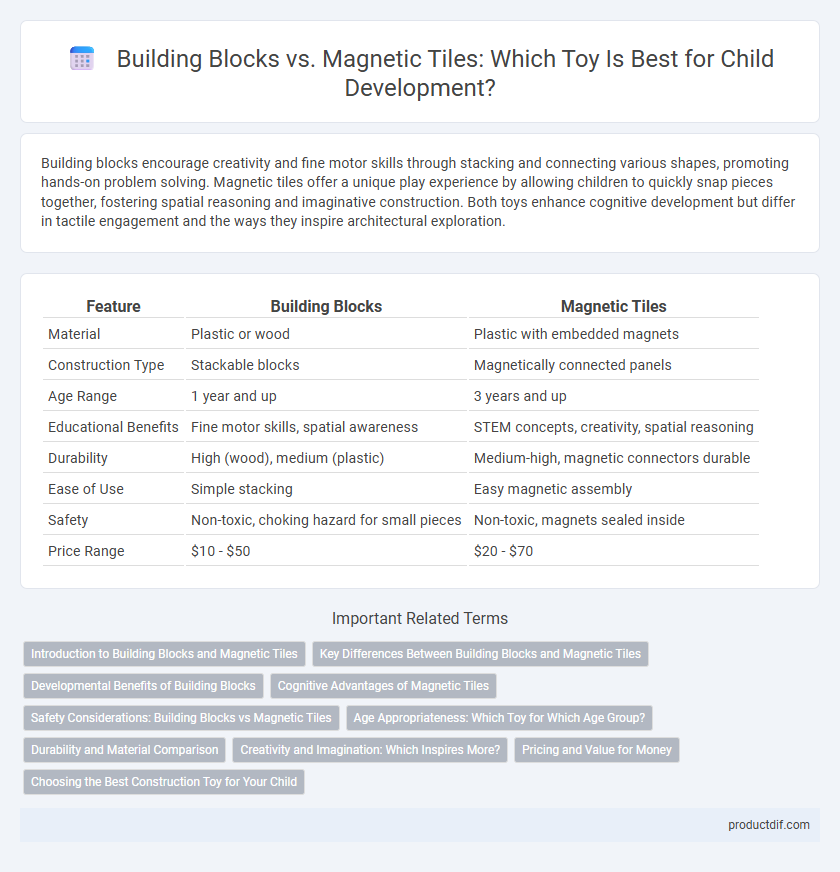Building blocks encourage creativity and fine motor skills through stacking and connecting various shapes, promoting hands-on problem solving. Magnetic tiles offer a unique play experience by allowing children to quickly snap pieces together, fostering spatial reasoning and imaginative construction. Both toys enhance cognitive development but differ in tactile engagement and the ways they inspire architectural exploration.
Table of Comparison
| Feature | Building Blocks | Magnetic Tiles |
|---|---|---|
| Material | Plastic or wood | Plastic with embedded magnets |
| Construction Type | Stackable blocks | Magnetically connected panels |
| Age Range | 1 year and up | 3 years and up |
| Educational Benefits | Fine motor skills, spatial awareness | STEM concepts, creativity, spatial reasoning |
| Durability | High (wood), medium (plastic) | Medium-high, magnetic connectors durable |
| Ease of Use | Simple stacking | Easy magnetic assembly |
| Safety | Non-toxic, choking hazard for small pieces | Non-toxic, magnets sealed inside |
| Price Range | $10 - $50 | $20 - $70 |
Introduction to Building Blocks and Magnetic Tiles
Building blocks are classic construction toys made from materials like wood or plastic, designed to develop fine motor skills, spatial awareness, and creativity in children. Magnetic tiles consist of colorful, translucent pieces with embedded magnets that allow for easy connection and encourage exploration of geometric shapes and magnetic properties. Both toys foster imaginative play, but magnetic tiles introduce interactive magnetic elements that expand building possibilities beyond traditional stacking.
Key Differences Between Building Blocks and Magnetic Tiles
Building blocks provide tactile, stackable pieces that foster creativity through manual dexterity and traditional construction techniques. Magnetic tiles feature embedded magnets allowing for effortless connection and three-dimensional designs that encourage spatial reasoning and exploration of magnetic forces. While building blocks emphasize solid, interlocking structures, magnetic tiles enable dynamic, flexible assemblies with instant attachment and detachment.
Developmental Benefits of Building Blocks
Building blocks enhance fine motor skills, spatial awareness, and problem-solving abilities in children by encouraging hands-on manipulation and experimentation. These toys promote creativity and cognitive development through stacking, balancing, and pattern recognition activities. Compared to magnetic tiles, building blocks also support tactile learning and improve hand-eye coordination by requiring precise placement and control.
Cognitive Advantages of Magnetic Tiles
Magnetic tiles enhance spatial reasoning and creativity through their unique magnetic connections, allowing children to build complex, three-dimensional structures with ease. These toys promote problem-solving skills and fine motor development by encouraging experimentation with balance and magnetism. Unlike traditional building blocks, magnetic tiles provide interactive learning opportunities that stimulate both scientific understanding and imaginative play.
Safety Considerations: Building Blocks vs Magnetic Tiles
Building blocks typically feature non-toxic, BPA-free plastic or wood, ensuring safe play with minimal choking hazards due to larger piece sizes. Magnetic tiles contain powerful rare-earth magnets, requiring close adult supervision to prevent accidental swallowing, which can cause serious internal injuries. Choosing age-appropriate sets certified by ASTM or EN71 standards is essential for both building blocks and magnetic tiles to guarantee safety.
Age Appropriateness: Which Toy for Which Age Group?
Building blocks are ideal for toddlers aged 1 to 3 years, enhancing fine motor skills and spatial awareness through simple stacking and sorting activities. Magnetic tiles suit children aged 3 and up, offering more complex construction possibilities that develop creativity and understanding of basic magnetism. Selecting the appropriate toy based on age ensures safe play and supports developmental milestones effectively.
Durability and Material Comparison
Building blocks are typically made from sturdy plastic or wood, offering high durability that withstands rough play and long-term use. Magnetic tiles feature strong magnets encased in plastic, which provide a unique building experience but may be more prone to wear or magnet weakening over time. When comparing materials, wooden blocks excel in longevity and resistance to damage, while magnetic tiles prioritize versatile, magnetic connectivity but require careful handling to maintain functionality.
Creativity and Imagination: Which Inspires More?
Building blocks stimulate creativity and imagination by allowing children to design unique structures through endless combinations of shapes and sizes, encouraging problem-solving and spatial awareness. Magnetic tiles enhance imaginative play by introducing the element of magnetism, enabling children to create 3D geometric shapes and explore magnetic forces, which fosters STEM learning alongside creativity. Both toys inspire imagination differently: building blocks promote open-ended construction while magnetic tiles add an interactive, science-based dimension to creative exploration.
Pricing and Value for Money
Building blocks typically offer affordable pricing and high value for money due to their simple design and durable materials. Magnetic tiles, though often more expensive, provide enhanced creative possibilities with their unique magnetic connections, increasing long-term play value. Parents seeking budget-friendly options may prefer building blocks, while those valuing innovative play experiences might invest in magnetic tiles despite higher costs.
Choosing the Best Construction Toy for Your Child
Building blocks enhance fine motor skills and creativity through hands-on stacking and balancing, while magnetic tiles promote spatial reasoning and open-ended exploration with their snapping magnetic edges. Selecting between building blocks and magnetic tiles depends on your child's developmental stage and interests, with blocks suitable for younger kids mastering basic coordination and tiles ideal for older children experimenting with complex structures. Both toy types encourage STEM learning, making either a valuable addition to foster problem-solving and imaginative play.
Building blocks vs magnetic tiles Infographic

 productdif.com
productdif.com